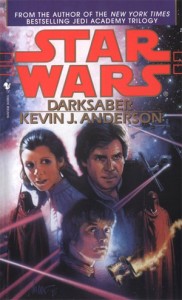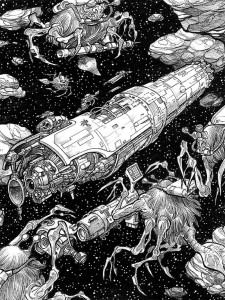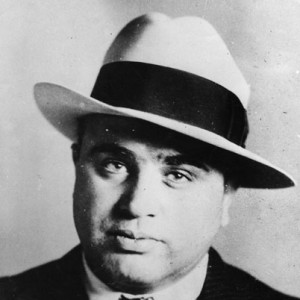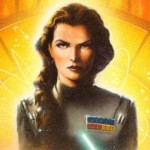 For those of you that have looked at my reviews in the past, you know that I have a propensity for hyperbole. And snark. Lots of snark. Kevin J. Anderson is a writer that I’ve thrown a lot of flak at in the past. Really, he’s been one of my favorite targets, and I’ll say this, he really does seem to bear a good bit of it. At a time not so far back, I’ve referred to him as being a kind of nemesis to me.
For those of you that have looked at my reviews in the past, you know that I have a propensity for hyperbole. And snark. Lots of snark. Kevin J. Anderson is a writer that I’ve thrown a lot of flak at in the past. Really, he’s been one of my favorite targets, and I’ll say this, he really does seem to bear a good bit of it. At a time not so far back, I’ve referred to him as being a kind of nemesis to me.
But to be honest, that was before I read some of the SWEU material that I was steered around the first time I was going through the Bantam/Spectra era books, which has been a long time ago. You know that the last review I did was for Children of the Jedi in a series of posts that went on for a bit too long. Barbara Hambly is likely not as bad a writer as she came across in that book, but it really seemed like she was pretty far outside her wheelhouse.
That book gave me a big dose of perspective for the concept of bad Star Wars. I had held that Anderson’s books were bad Star Wars up to a point, but something else has come to my attention. There’s a difference between bad Star Wars and not good Star Wars. Children of the Jedi was bad. Darksaber isn’t bad Star Wars; in fact it fits in with my usual prerequisites for being pretty good, but it has a pretty long list of bad features that throw it out of that.
I can say something good about Kevin J. Anderson up front. I swear, just watch. The Jedi Academy Trilogy established some very important aspects of the Expanded Universe at large. I didn’t like it. I didn’t like the way it was written, but for anyone who is coming into the EU from the start of the Bantam/Spectra era, it’s pretty much required reading. For anybody who is wondering where the Academy came from, it’s important. Let’s be honest, if you’re looking at anything except the core of the New Republic Era, anything later pretty much encourages you to read it. The characters and concepts that get to be important later on have their sources there.
Now, you don’t want to read this; it isn’t the funny bit. Me talking about the stuff that’s wrong–that’s what you want. So, here’s where we stand, I’m going to break this down into just two parts, I’m not running a page by page analysis, you’re going to get the problems at large as I see them. For me, Darksaber has two fronts of problems. There’s the distinct storytelling issues and there’s the technical issues.
For today’s post, we’re going to focus on the former of the two. Hit the jump to see the story elements of this book that crawl under my skin.

Clearly the most dangerous literal cannon in the galaxy. As long as you're right in front of it. And the computer works. And the untrained crew manages to do things right. And it was designed well. And it was built with quality parts. And it's not in a giant rock crusher of a stellar mass.
My problems with Anderson have pretty much one source for me. He doesn’t ever seem to be interested in learning any more about what he’s writing about than what he already knows. It shows when he talks about technology and in the grand scheme of his story arcs. Darksaber falls under the same type of story that one of the primary plots of the Jedi Academy series did. Somebody that we don’t want to have a superweapon is coming into possession of one.
Fine, whatever. It’s the same story as ANH and RotJ, big bad thing that needs to be destroyed and I can’t blame him for doing it, but it’s the same story that was just told in the previous book, Children of the Jedi. At this point it’s starting to show some attrition on the reader. It gets to the point that you get past caring; there are only so many times that the bad guys can build the Death Star and you still care. By my count, this is the fourth time in continuity that a major plot point of a story has been the Death Star. Like, literally, the Death Star. Here’s the list, Episode IV ANH, Episode VI RotJ, Jedi Academy and Darksaber. It’s getting pretty old.
Alright, that’s one problem–you can’t read the same story too many times before you stop caring about it. So, here’s another problem, and it’s the same one that I had with Princess Leia in the past. If she is the leader of the New Republic, and I forget her title, chancellor or president, whatever it ends up being, she’s still doing everything herself.
There’s some sense to this, I know. She’s an established character, it’s possible that there are some readers that are looking at this particularly because Leia is in it. If we put her in the role of an administrator, then she can’t do anything. Straight up, nothing. But realistically, in what world do the leaders of major states do their own work?
It’s going to end up being dumb as long as this is the case. Now, for a point of comparison, I want you to look at another major character that starts out as a hero and moves into the role of an administrative leader. Tom Clancy’s books have been focusing on a character named Jack Ryan, who starts out as having been a marine, now retired from the military and teaching at the Naval Academy. He gets taken into the CIA as an analyst and eventually a rather informal field agent. By the time we’re essentially done with Jack, he’s the president, and his hands are a bit tied.
So, when you have an established character who is suddenly not a viable, boots on the ground hero anymore, what do you do? You write up new stories with different characters! After Jack Ryan becomes president, we start reading books about groups like Rainbow Six. We follow someone else for a while, but you ease the readers into it and make a gradual transition as one character slowly moves out of the limelight and the new one moves in.
Nobody else is capable of dealing with these kinds of issues? I know I keep bringing this up, but she doesn’t have a special fire-team, an intelligence organization, or a certain team of comamandos under a guy named Page? Why in the galaxy should this continue? It feels like such lazy writing.
On a further note about the behavior of the head of a major state, do you honestly expect me to believe that she’s taking meeting with a known crime lord? Durga the Hutt, a character I’m about to skewer by himself, has a meeting in the Imperial Palace with Princess Leia. Not only does he get the meeting, but he gets to set the terms.
Hold on, what? The leader of the free galaxy is meeting with a crime boss and he gets to bring along something like ninety of his pets. These pets of his are not something that we’ve ever seen before, by the way. Nobody has, they’re small and monkey-like, the description made me think that he’d brought a bunch of little Salacious Crumbs. Durga says he found them out in the rim and that they’re a hive mind. Sure, the Republic doesn’t know that, but seriously? You’re having a meeting with a crime boss and he has little unidentified aliens that he’s calling pets. You know what else are pets? Aggressive pit bulls. And to our knowledge, there’s one guard in the room.
I’m so not even kidding here, can you imagine for a moment that someone came to
see the President of the United States, no, wait. Not somebody. Let’s say that Al Capone came to see President Hoover and brought silverback gorillas. Paint that picture in your head real quick. A gorilla wasn’t a known creature at this point, so the secret service just assumes that they’re friendly, right? I mean, after all, what would Al Capone gain from attacking the president?
Let’s move on. Durga the Hutt. I have a few problems with Durga the Hutt. You know what, scratch that, I have a pretty big pile of issues with the Hutts. Why do we have to have these many stereotypes in Star Wars? I understand that Jabba was a Hutt and that, in what is a rather screwed up way, they’re analogous to the stereotype of Italian crime bosses. But why are all Hutts crime lords? I mean, it’s a whole race. They literally can’t all be (a) in charge and (b) in the same line of work. Why can’t we have different races in charge of these things? Be fair, a few years later, maybe that same year, I forget, we got Shadows of the Empire and despite all of that book’s flaws, it had a different kind of alien in charge!
Now, that’s the primary plot line, there’s a whole other story of the Empire and how it is acting at this point. The author is using a character of his own creation, something I can’t fault him for; in fact, I rather applaud it. Again, I don’t like the character, but Admiral Daala is at least something different.
But here’s what I don’t understand. Daala is a character who, prior to this book, had operated alone and was wholly unknown to the rest of the galaxy. She was assigned to a secret installation far away from the rest of the galaxy and literally forgotten. Do you remember why she was forgotten? It was because she was secretly assigned there by Grand Moff Tarkin. So, how does anyone recognize her authority? She’s referred to as being an Admiral, but she’s still fairly young when we first meet her. Wookieepedia seems to insinuate that Tarkin took her straight out of the academy and put her in command at the Maw.
If that’s the case, she has no experience in combat outside of what we saw in the
Academy books. Admiral Harrsk is nice enough to give a list of what is apparently evidence enough to make her a ‘war hero.’ What all is on that list? Well, she defended the Maw for nearly ten years after the fall of Palpatine, she had her sorry butt kicked by a handful of Republic pilots, she takes the Star Destroyers and prototype Death Star out, assaults a convoy, attacks a colony and the academy. In those missions, maybe I missed one, but she managed to lose three Star Destroyers and the last one was so badly damaged that it was not able to be repaired.
That constitutes a war hero?
And while we’re on the Imperials, the author keeps talking about the remaining Imperial Warlords. Really? I mean, I know this was something that we dealt with outside of these books, but nobody does that. A person who seizes power after a collapse, regardless of whether or not they are a warlord, they don’t call themselves a warlord! They assign themselves a rank or outwardly legitimate political position. It’s all about that, legitimacy. In the world of politics, if you can make your enemy call you something like Chancellor, President, or Prime Minister. If you can make your enemy do that, then you manage to gain an assumed level of legitimacy. So when I read ‘Supreme Warlord Harrsk,’ and he’s calling himself that, then I get a bug under my skin.
Ultimately, I have this to say about this book. In my mind, there is a list of books out of this era that are important for new readers to experience. They add new characters, they show us how we go from one instance to the next and why the experiences were important. Any of Zahn’s books from this era are on that list, the X-Wing novels are there, even Jedi Academy is on it. This book isn’t. And there’s a really good reason. This book does not add anything to the greater narrative of the EU. If you need to know anything at all from it, it’s this. Admiral Daala executes a large number of warlords (note the lower case, it’s not formal) and she seizes control of the Imperial Remnant. That doesn’t stay that way, because Pellaeon ends up in control until he retires. So, all that said, there is nothing in this book that is actually important in the grand scheme. Do you know what that makes this book? A filler episode. Nobody’s ever going to hold up the filler episodes as their favorites. And that sums up my opinion about the story of this book.
Check in again soon for when I go into my second part of this review, when I break down all of my technical problems with this book. That is when it’s going to get funny.




Interesting – I actually was rather interested in the Imperial restructuring (cause Fleet wars, yo!), but I agree that this book is completely filler.
Though I’m not sure why JAT is essential reading when we have I, Jedi in all it’s recappy goodness to cover those important points, plus added good writing and better plot…